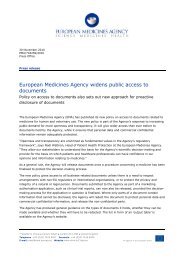1 Selective serotonin reuptake inhibitors (SSRI) â sales, withdrawal ...
1 Selective serotonin reuptake inhibitors (SSRI) â sales, withdrawal ...
1 Selective serotonin reuptake inhibitors (SSRI) â sales, withdrawal ...
You also want an ePaper? Increase the reach of your titles
YUMPU automatically turns print PDFs into web optimized ePapers that Google loves.
In contrast, according to the precautionary principle even weak signals, from the collection of<br />
adverse effects, rather than definite proofs, could lead to warnings or restrictions in the market<br />
authorisation.<br />
Drug regulators have been guided by the definitions of dependence and <strong>withdrawal</strong> reactions in<br />
DSM-IV and ICD-10, but not consistently. For example, they preferred the term <strong>withdrawal</strong><br />
reactions to the term discontinuation reactions, suggested by the pharmaceutical industry. But when<br />
<strong>SSRI</strong>s actually met 2 out of the required 3 criteria for the diagnosis of dependence, this was not<br />
accepted by drug regulators as dependence.<br />
Spontaneous reporting of adverse effects<br />
The pharmaceutical companies receive reports about adverse effects from doctors and drug<br />
regulators, assess a possible relationship to their drug, and produce periodic safety update reports,<br />
which they submit to the drug agencies. The underreporting of adverse drug reactions has been<br />
estimated by to be around 90% or more (25), which means that we often lack knowledge about the<br />
frequency and seriousness of adverse effects.<br />
When a drug is marketed, there is only limited knowledge about adverse effects, and the perception<br />
of the balance between benefit and harm will therefore often change over time. For around half of<br />
the drugs, label changes because of serious risks that are only revealed after marketing are<br />
introduced (4). The spontaneous reporting system is therefore slow in detecting signals of harm. For<br />
this reason, the importance of a transparent cause-effect assessment built on a precautionary<br />
principle has been suggested (26, 27). This might be in contradiction to European drug legislation,<br />
which is based on a risk management principle (28). When signals of adverse drug reactions have<br />
turned up it, is the responsibility of drug authorities to re-assess the risk-benefit relation, and to<br />
assess if there is a basis for changes in the market authorization.<br />
Benzodiazepines and abuse potential<br />
In 1967, there were warnings that benzodiazepines were used illicitly, particularly by the youth and<br />
in countercultures (29). In 1979, US Congress initiated a hearing about the “Valium scare”, because<br />
of the “growing of a very serious public health problem of which American people may not be<br />
aware”. As a result of the hearing, the benzodiazepines were regulated by the Drug Enforcement<br />
Agency (DEA) and categorised as Schedule IV drugs in the Controlled Substances Act of 1970,





